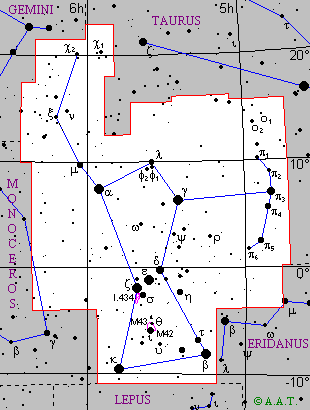 |
 |
| English name | Orion | ||||
|---|---|---|---|---|---|
| Major stars | alpha Orionis | Betelgeuse | magn. 0,5 | RA: 05h 55m 10.32s | Dec: +07° 24' 25.4" |
| beta Orionis | Rigel | magn. 0,1 | RA: 05h 14m 32.28s | Dec: -08° 12' 06.0" | |
| gamma Orionis | Bellatrix | magn. 1,6 | RA: 05h 25m 07.86s | Dec: +06° 20' 58.7" | |
| delta Orionis | Mintaka | magn. 2,4 | RA: 05h 32m 00.40s | Dec: -00° 17' 56.8" | |
| epsilon Orionis | Alnilam | magn. 1,8 | RA: 05h 36m 12.81s | Dec: -01° 12' 07.0" | |
| zeta Orionis | Alnitak | magn. 2,0 | RA: 05h 40m 45.52s | Dec: -01° 56' 33.5" | |
| eta Orionis | magn. 3,4 | RA: 05h 24m 28.64s | Dec: -02° 23' 49.4" | ||
| iota Orionis | magn. 2,9 | RA: 05h 35m 25.98s | Dec: -05° 54' 35.6" | ||
| kappa Orionis | Saiph | magn. 2,2 | RA: 05h 47m 45.39s | Dec: -09° 40' 10.8" | |
| pi3 Orionis | magn. 3,3 | RA: 04h 49m 50.34s | Dec: +06° 57' 40.6" | ||
| Description | Splendid constellation of the equatorial region, emphasized by a big number of bright stars assembled in a not very vast zone. In particular there are Betelgeuse, a red supergiant 300 light-years away, and Rigel, a blue supergiant 900 light-years away, that with its magnitude 0,1 is the seventh star in order of brightness. A peculiarity of the constellation is a trio of stars set on a line between Betelgeuse and Rigel: they are Mintaka, Alnilam and Alnitak, which individualize Orion's belt. Mintaka and Alnitak are two double stars: to observe the first one you need only small instruments, while the second one is more difficult to be separated since its two components are very near. Another interesting star is sigma Orionis, situated just under the belt: seen with a small telescope, it shows to be a white-blue star accompanied by well three more weak stars; this gives the impression to see a planet with three satellites.
|
||||
| Mythology and history | Orion was a skilled hunter, son of Poseidon: he was a giant and he was so tall that he could walk on the sea-bed holding his head out of water. One day Orion arrived at the Chio island, where he asked the king Aenopion for the hand of his daughter Merope: Aenopion consented, on condition that before Orion killed all the beasts that infested his kingdom; but after the giant had completed this exploit, Aenopion didn't fulfil his promise. Orion became very angry, and after having got drunk he raped Merope: therefore Aenopion ordered to blind him and to banish him from Chio. The giant succeeded in reaching Lemno, where he asked the young Caesalius, assistant in the forge of Ephestus, to put on his shoulders and to guide him eastwards: an oracle, in fact, foretold him that he would have recovered the sight if he had directed toward the rising Sun. And so it happened. About Orion's death there are different stories. A version tells that the giant boasted to be the best hunter ever existed: Artemis, the goddess of hunting, indignant and offensed, make a big scorpio to come out from a fissure and to prick Orion to death. For this reason in the sky, when Scorpius rises, Orion hides himself under the west horizon. In the sky Orion is represented while he is raising the shield (that is the arc of stars denominated pi Orionis) and the cudgel (chi1 and chi2 Orionis) to defend himself from Taurus which is charging him. |
||||
 Back to constellations page.
Back to constellations page.